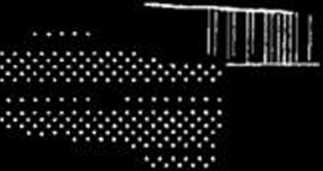8589356520
FLINT MINING OF CENTRAL EUROPE 23
towards this view recently (1971, 120 f.; 1975, 162). As can be seen from the publication by F. Kirnbauer (1958) and N. N. Gurina (1976), this kind of raw materiał exploitation also occurred on a smali scalę at the mines on Vienna-Mauer and Krasnoye Selo. The volume of cxlruded raw materiał and waste rock was usually from 1 to 5 m3 approx. Surface pit cxploitation difTers clearly
3. OPEN
Opcn shafts exploitation reąuired much morę work with the participation of at least two people, better knowledge, and morę mining experience. In such workings knowledgc, and morę mining experience. In such workings, a kind of communication step was often left to lift flint and waste materiał to the surfacc. The volume of extruded materiał ranged from 3 to 80 m3, taking into account the known workings from Central Europę. Open shafts are the most common form of exploitation unit of the early farming communilics. Among others we know the hornstone minę at Lengfeld (Reisch 1974), quartzite mines at TuSimice and Bećov (Neustupny 1963; 1966; 1976; Kruta 1966; Fridrich 1972), the radiolarian chert minę at Tata-Kalvśria Hill (Fulóp 1973; 1975) and partly at Stirneg (Vertes 1964; Bścskai 1976), Ju-rassic-Cracow flint mines at Sąspów and Jerzmanowice-Dąbrówka (Lech 1972; 1975b; 1981), and “chocolate” flint mines at Tomaszów and Polany II in the north-eastern fringes of the Holy Cross Mountains (Chmielewska, Lech 1973; Lech 1975 a, 143 f.; Schild 1975; 1976a, 158-161). Open shafts occur side by side with othcr types of shafts on the territory of the mines at Rijckholt—St.Geertruid (W. M. Felder et alii 1979, 56 f.), Krzemionki Opatowskie (Krukowski 1939, 11-13) and at Krasnoye Selo (Gurina 1976, 132-163).
Among this catcgory of workings we can observe a elear division into two groups: narrow shafts and wide shafts. They often occur side by side at the same mines — for example at Lengfeld and Tomaszów. At Lengfeld the shafts were sunk through a layer of loess, gravel trains and clay with rounded Calcerous rubbish and nu-merous flint nodules, down to the roof of the limestone
from the extraction of raw materiał from sea-shore sli-des, cluvial or glacial clays, or river gravel trains. As we shall see in further considerations, it is also clearly difierent from open shaft exploitation of the deposit; in other words it is primitivc in A. L. Armstrong's classi-fication or Mardellen Grubenbau of M. Jahn and E. Schmid.
SHAETS
rock (Reisch 1974, 33-35, Beilage I). One of the shafts (Schacht I) was 95 cm wide at the mouth, directly below the soil floor. It was 225 cm deep (Fig. 25). The second shaft (Grube II) was about 4 m wide at the mouth,

Fig. 25. Lengfeld, Kelheim dist. Narrow open shaft
A — soil; B — loess; C — layer of fine gravcl; D — eluvial clay with limę rubble and raw materiał; E — mother rock or waste weathering;/-// — sediments in secondary position: limę rubble with loess (/) loess (g); ełuvial clay with limę rubble (/i); I - shaft
After L.Reisch
and 2 m in depth (Fig. 26). At Tomaszów, distr. Radom the shafts were cut through sands, washed down forma-tions and eryo-turbated deposits of the Middle and Uppcr Wiirm periods. Flint nodules were extruded from the Karstic clays which lay below. The shafts were from 1.2 m to morę than 3m wide and from 3.5 to 4.5 m deep (Schild 1975, 17; 1976a, 158-161).
Only big, wide shafts are known from the territory of the flint minę at Sąspów. The natural stratigraphy therc is as follows: top soil, subsoil, loess, karstic clay, limes waste and Upper Jurassic calcerous bedrock. In

Fig. 26. Lengfeld, Kelheim dist. Wide, open shaft. Kcy as for fig. 25; II — shaft
After L.Reisch
Wyszukiwarka
Podobne podstrony:
FLINT MINING OF CENTRAL EUROPE 15 Fig. 13. Gorzów Wielkopolski-Chwalęcice. Kłodawka rivcr gap at mor
FLINT MINING OF CENTRAL EUROPE 17 as “chains” (Fig. 16). Very big nodules (approx. 40 cm) are vcry r
FLINT MINING OF CENTRAL EUROPE 19 IV. REMARKS ON THE TER MS “MINĘ” AND “MINING” IN THE RESEARCH ON
FLINT MINING OF CENTRAL EUROPE 21 Fig. 20. Gorodok, Rovnc dist. Visncvaya Góra sile / — Plan of thc
FLINT MINING OF CENTRAL EUROPE 25 loam laycrs to sandstone. Quartzite was extruded from thc sandston
FLINT MINING OF CENTRAL EUROPE 27 Fig. 34. Kalvśria Hill. Tata. Section of shaft 2 / - from thc Sout
FLINT MINING OF CENTRAL EUROPE 31 FLINT MINING OF CENTRAL EUROPE 31 Fig. 43. TuSimicc, Chomutov dist
FLINT MINING OF CENTRAL EUROPE 7 meration in the earth crust could bc rccognizcd as a de-posit. In p
FLINT MINING OF CENTRAL EUROPE 35 Fig. 51. Rijckholt—St.Geertruid, Maastricht dist. Schematic scctic
FLINT MINING OF CENTRAL EUROPE 39 1973, 185 187) and obscrvations madę by S. Krukowski at Krzemionki
FLINT MINING OF CENTRAL EUROPE 41 rounded; the other one is transversely “cut”, for use as a hammer
FLINT MINING OF CENTRAL EUROPE 49 Tablc 2. Radiocarbon dates from other areas of prehistorie flint m
FLINT MINING OF CENTRAL EUROPE 51 sia, in Opava Silesia, and in north-wcst Moravia. Jasper exploitat
53 FLINT MINING OF CENTRAL EUROPE Damon P.E., Łono A. 1962 Arizona Radiocarbon Dat es III, “Radiocar
FLINT MINING OF CENTRAL EUROPE 55 Rook E. 1963 Materiały z jaskini Bęblowskiej Dolnej, „Materiały
Regarding the bending moments, it can be seen from the equi-iibrium of the element that they are not
FLINT MINING OF CENTRAL F.UROPEof chief siliceous rocks, mincs and probable min es in Central Europę
FLINT MINING OF CENTRAL F.UROPE 33 5. UNDERGROUND SHAFTS WITH NICHES Underground shafts with niche w
FLINT MINING OF CENTRAL HUROPE 37 tion as a result of connccting the workings of three ad-jacent sha
więcej podobnych podstron